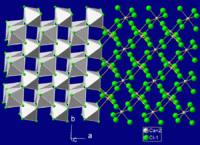- Chromium(II) chloride
-
Chromium(II) chloride Chromium(II) chlorideOther namesChromous chlorideIdentifiers CAS number 10049-05-5 
PubChem 24871 ChemSpider 23252 
UNII CET32HKA21 
RTECS number GB5250000 Jmol-3D images Image 1 - Cl[Cr]Cl
Properties Molecular formula CrCl2 Molar mass 122.902 g/mol Density 2.9 g/cm3 Melting point 824 °C
Boiling point 1120 °C
Solubility in water soluble Structure Crystal structure Orthorhombic (deformed rutile), oP6 Space group Pnnm, No. 58 Coordination
geometryoctahedral, 6-coordinate Hazards MSDS Oxford MSDS EU Index Not listed LD50 1870 mg/kg (oral, rat) Related compounds Other anions Chromium(II) fluoride
Chromium(II) bromide
Chromium(II) iodideOther cations Chromium(III) chloride
Chromium(IV) chloride
Molybdenum(II) chloride
Tungsten(II) chloride (verify) (what is:
(verify) (what is:  /
/ ?)
?)
Except where noted otherwise, data are given for materials in their standard state (at 25 °C, 100 kPa)Infobox references Chromium(II) chloride is the chemical compound with the formula CrCl2. This white, crystalline solid is used for the synthesis of other chromium complexes. CrCl2 is hygroscopic. It dissolves in water to give bright blue solutions that are easily oxidized by air to give Cr(III)-containing products. CrCl2 crystallizes with the calcium chloride structure, an orthorhombically distorted variant of that of rutile.
Contents
Synthesis
CrCl2 is produced by reducing chromium(III) chloride with hydrogen at 500 °C:[1]
- 2 CrCl3 + H2 → 2 CrCl2 + 2 HCl
Small scale preparations can use LiAlH4, or related reagents, to reduce CrCl3
- 4 CrCl3 + LiAlH4 → 4 CrCl2 + LiCl + AlCl3 + 2 H2
Commonly, it is generated by reduction of CrCl3 with zinc.
- 2 CrCl3 + Zn → 2 CrCl2 + ZnCl2
Reactions
Chromium(II) chloride reacts with any small amount of acid in the water to form hydrogen gas:
- 3 CrCl2 + H2O → 2 CrCl3 + CrO + H2
The reduction potential for Cr3+ + e– ⇄ Cr2+ is −0.41. The reduction potential for water in acidic conditions is +0.00, making the reaction occur easily. The reaction in basic environments is:
- CrCl2 + 2 OH– → Cr(OH)2 + 2 Cl–
This reaction forms a precipitate of chromium(II) oxide.
Uses
Chromium(II) chloride is used as precursor to other inorganic and organometallic chromium complexes. Alkyl halides and nitroaromatics are reduced by CrCl2. The moderate electronegativity of chromium and the range of substrates that CrCl2 can accommodate make organochromium reagents very synthetically versatile.[2] It is a reagent in the Nozaki-Hiyama-Kishi reaction.
References
- ^ Burg, A. B. (1950). Audrieth, Ludwig F.. ed. "Anhydrous Chromium(II) Chloride". Inorg. Synth. 3: 150–153. doi:10.1002/9780470132340.
- ^ Kazuhiko Takai, K.; Loh, T.-P. "Chromium(II) Chloride" in Encyclopedia of Reagents for Organic Synthesis John Wiley & Sons: New York; 2005. doi:10.1002/047084289X.rc166.
- Greenwood, Norman N.; Earnshaw, Alan (1997). Chemistry of the Elements (2nd ed.). Oxford: Butterworth-Heinemann. ISBN 0080379419.
External links
Chromium compounds Categories:- Chromium compounds
- Chlorides
- Reducing agents
Wikimedia Foundation. 2010.

